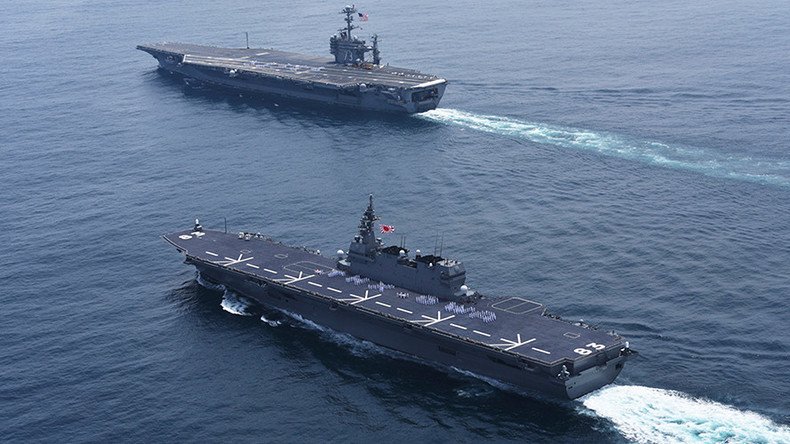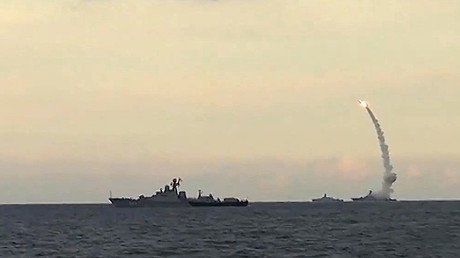US aircraft carriers may lose sea dominance to Russia, China – study

The era of the US global sea dominance – ensured by its 10 giant aircraft carriers – may come to an end, a study by respected Washington-based think tank warns. Russia, China and Iran can make the mammoth vessels useless by new weapons, tech and tactics.
Aircraft carriers are at the heart of the US Navy's global reach capabilities, and a symbol of American military might. The fearsome dreadnoughts can practically endanger any part of the world by deploying their air groups, comprising fighter and strike jets, as well as surveillance and electronic intelligence aircraft.
Every war the US waged during recent decades, including the 1990-1991 Gulf War, Yugoslavia, Afghanistan and Iraq, involved their use.
The US Navy currently has 10 aircraft carriers in active service, which is equal to what all other countries can field combined.
On Monday, the Washington-based bipartisan Center for a New American Security (CNAS) released a report saying the era of American naval dominance may end soon.
.@CNASdc Yes, which @zvezdanews couldn't wait to translate as "American Military Superiority is Over," https://t.co/637gubRIrP@kelleysayler
— Tom Moore (@TColinMoore) February 22, 2016
“While the US Navy has long enjoyed freedom of action throughout the world’s oceans, the days of its unchallenged primacy may be coming to a close,” the paper warns.
“No longer will aircraft carriers and their associated air wings be able to operate with impunity. Instead, they will face a dense and growing threat across their full range of operations.”
.@NimitzNews receives massive upgrade to increase efficiency, security, and communication - https://t.co/pweDx2QJ5upic.twitter.com/VI2rggSARu
— U.S. Navy (@USNavy) February 19, 2016
The core danger faced by the Navy, the report says, is that Russia, China and Iran, seen as America's virtual adversaries, are perfecting “area denial” (A2) methods of blocking off combat areas. A2 means that American carriers and their planes are unable to get close enough to fight effectively without suffering severe damage or even destruction.
The study, titled: “Red Alert: The Growing Threat to US Aircraft Carriers,” lists “advanced air defense systems, anti-ship cruise and ballistic missiles, submarines and aircraft carriers.”
These capabilities are likely to become more widespread in the years to come, the military analysts say, placing greater constraints on US carrier operations “than ever before.”
While the study primarily focused on China’s naval capabilities, it also says the People’s Liberation Army Navy (PLAN) utilizes a great deal of “increasingly lethal” Russian-made weaponry.
China’s four Russian-built Sovremenny guided missile destroyers also operate an advanced anti-ship cruise missile – 3M80ME Moskit (SS-N-22 Sunburn in NATO classification) – with each ship capable of launching eight missiles.
These missiles, according to the report, can evade the sophisticated Aegis missile defense shield used by the US Navy and devastate any large target at sea – including an aircraft carrier – at ranges of 120 to 240 kilometers (65 to 130 nautical miles) with its semi-armor piercing warhead.
Approximately 40 batteries of Russian-built S-300 air defense systems are in use with the Chinese military, the study added. It cites the Pentagon’s assessment of it as “one of the largest forces of advanced long-range surface-to-air systems in the world,” that would make carrier-launched airstrikes inefficient and dangerous.
Russian upgraded S-400 systems can also extend any user’s ability to strike incoming targets at ranges of 398 kilometers (215 miles) – a range large enough to cover the entirety of China's exclusive economic zone.
In November 2015, Russia deployed its state-of-the art S-400 anti-aircraft systems to Syria. They allow targeting planes over the entire country and much of the eastern Mediterranean.
While the Pentagon is investing billions of dollars in breakthrough naval weapons technologies, like jamming, spoofing, dazzling, kinetic strikes and passive avoidance, to safeguard its carrier fleet, they could be less efficient than expected.
“It is highly unlikely that they could wholly neutralize a saturation attack against US forces,” the report concludes.













